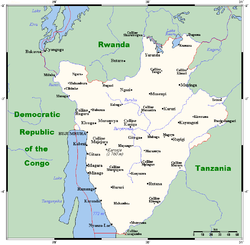
Geography of Burundi
About this schools Wikipedia selection
This content from Wikipedia has been selected by SOS Children for suitability in schools around the world. All children available for child sponsorship from SOS Children are looked after in a family home by the charity. Read more...
| Geography of Burundi | |
|---|---|
 |
|
| Continent | Africa |
| Region | Central Africa |
| Coordinates | 3°30′S 30°0′E |
| Area | Ranked 153rd 27,830 km2 (10,750 sq mi) 92.2% land 12.8% water |
| Borders | 974 km (DROC 233 km, Rwanda 290 km, Tanzania 451 km) |
| Highest point | Mount Heha 2670 m |
| Lowest point | Lake Tanganyika 772 m |
| Largest lake | Lake Tanganika |
Burundi is located in central Africa, to the east of the Democratic Republic of the Congo, at the co-ordinates 3°30′S 30°0′E.
Physical geography
Burundi occupies an area equal to 27,830 square kilometres in size, of which 25,650 km² is land. The country has 974 kilometres of land border: 233 km of which is shared with the Democratic Republic of the Congo, 290 km with Rwanda and 451 km with Tanzania. As a landlocked country, Burundi possesses no coastline, although it straddles the crest of the Nile-Congo River watershed.
Climate
Burundi in general has a tropical highland climate, with a considerable daily temperature range in many areas. Temperature also varies considerably from one region to another, chiefly as a result of differences in altitude. The central plateau enjoys pleasantly cool weather, with an average temperature of 20 °C (68 °F). The area around Lake Tanganyika is warmer, averaging 23 °C (73.4 °F); the highest mountain areas are cooler, averaging 16 °C (60.8 °F). Bujumbura’s average annual temperature is
23 °C (73.4 °F). Rain is irregular, falling most heavily in the northwest. Dry seasons vary in length, and there are sometimes long periods of drought. However, four seasons can be distinguished: the long dry season (June–August), the short wet season (September–November), the short dry season (December–January), and the long wet season (February–May). Most of Burundi receives between 1,300 and 1,600 mm (51.2 and 63.0 in) of rainfall a year. The Ruzizi Plain and the northeast receive between 750 and 1,000 mm (29.5 and 39.4 in).
Terrain
The terrain of Burundi is hilly and mountainous, dropping to a plateau in the east. The southern and eastern plains have been categorised by the World Wildlife Fund as part of the Central Zambezian Miombo woodlands ecoregion.
The lowest point in the country is at Lake Tanganyika, at 772 m, with the highest point being on Mount Heha, at 2,684 m. Natural hazards are posed in Burundi by flooding and landslides.
Environment
Current issues
Soil erosion is an issue for Burundi, and is as a result of overgrazing and the expansion of agriculture into marginal lands. Other issues include: deforestation, due to the uncontrolled cutting-down of trees for fuel; and habitat loss threatens wildlife populations.
International agreements
Burundi is a party to the following international agreements that relate to the environment: Biodiversity, Climate Change, Desertification, Endangered Species, Hazardous Wastes and Ozone Layer Protection. The following have been signed but not yet ratified by Burundi: Law of the Sea and Nuclear Test Ban.



